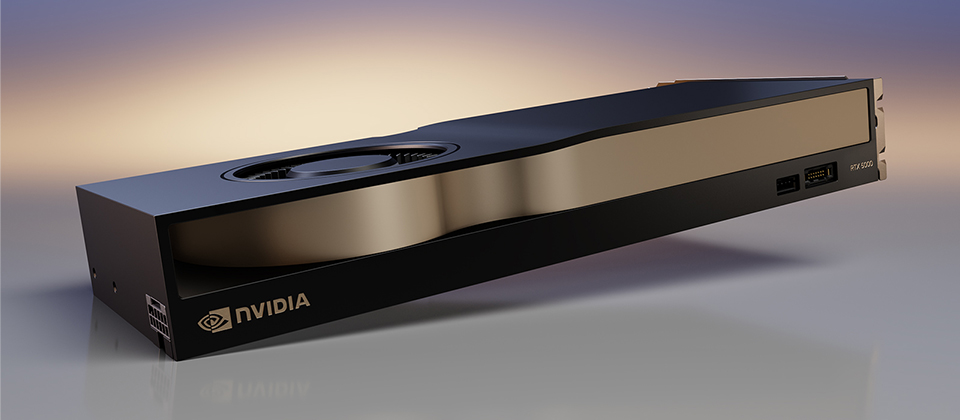Over the past year, Nvidia has successively launched a number of professional graphics accelerator cards that have introduced the Ada Lovelace architecture. The first is the RTX 6000 Ada Generation that debuted at the GTC Autumn Conference in September last year, and at the GTC Spring Conference in March this year,The company announced more GPU products using this architecturesuch as: RTX 4000 SFF Ada Generation that can be installed on a desktop computer workstation, and a variety of independent GPU chips integrated in a notebook workstation, for example, RTX 5000, RTX 4000, RTX 3500 with Ada Generation on the end of the name , RTX 3000, RTX 2000.
At the Siggraph conference held in the first half of August, Nvidia continued to launch three professional graphics GPUs for desktop computer workstations, namely: RTX 5000, RTX 4500, and RTX 4000, all of which use the Ada Lovelace architecture. Therefore, the suffix of the full name of the product is Labeled Ada Generation, emphasizing that it can provide the latest AI, graphics processing, and real-time rendering technologies.
Among them, the RTX 5000 has been sold, and the RTX 4000 and RTX 4500 are expected to be launched in September and October.
Compared with the previous generation of professional graphics accelerator cards using the Ampere architecture, the computing performance of these products can be doubled at most. For single-precision floating-point processing, the CUDA core with the new architecture can provide twice the performance. For example, the existing RTX A5000 is 27.8 TFLOPS, and the new RTX 5000 Ada Generation is 65.3 TFLOPS.
For AI training work, the new product with the fourth-generation Tensor core can achieve twice the performance, and because of the expanded support for FP8 computing processing, the performance can be further improved by using loose processing at the same time. For example, the Tensor performance of the current RTX A5000 is 222.2 TFLOPS, and the Tensor performance of the RTX 5000 Ada Generation is 1044.4 TFLOPS.
When performing ray tracing with shading or noise reduction at the same time, these new products with third-generation RT cores can provide 2 times the throughput. For real-time graphics processing with AI computing, since the Ada Lovelace architecture uses a new Optical Flow Accelerator (Optical Flow Accelerator) and AI frame generation (AI frame generation), it can support the third generation of deep learning ultra-high sampling developed by Nvidia Technology (DLSS 3) computing, raising the fidelity and interactivity of images to a new level.
Regarding the use of multimedia coding standards, because the Ada Lovelace architecture is aimed at the increasingly popularAV1 provides more complete support, jointly benefiting this batch of new professional graphics accelerator cards. Like RTX A5000 built-in AV1 decoding engine, RTX 5000 Ada Generation also provides AV1 encoding and decoding engine.
In terms of GPU memory configuration, Ada Generation products also provide larger capacity. For example, RTX A5000 and RTX A5500 both have built-in 24 GB memory for both 5000-level models, and 32 GB for RTX 5000 Ada Generation; both belong to 4000-level models, RTX A4500 and RTX A4000 are equipped with 20 GB and 16 GB memory respectively 24 GB with RTX 4500 Ada Generation and 20 GB with RTX 4000 SFF Ada Generation.
However, if we compare the two generations of products in terms of GPU memory access specifications, we can find that the new product does not necessarily have a stronger configuration. For example, the memory interface of RTX A5500 and RTX A5000 is 384 bits and the bandwidth is 768 GB/s, but the RTX 5000 Ada Generation is 256 bits and 576GB/s; the memory interface of RTX A4500 is 320 bits and the bandwidth is 768 GB/s. The width is 640 GB/s, RTX 4500 Ada Generation is 192 bits, 432 GB/s; the memory interface of RTX A4000 is 256 bits, bandwidth is 448 GB/s, RTX 4000 Ada Generation is 160 bits, 360 GB/s.
The only exception is the RTX A6000 and RTX 6000 Ada Generation models, both of which use a 384-bit interface with bandwidths of 768 GB/s and 960 GB/s respectively.
Product Information
Nvidia RTX 5000 Ada Generation
●Original manufacturer: Nvidia
●Suggested selling price: starting at $4,000
●Number of CUDA processing cores: 12,800
●Number of Tensor Cores: 400
●Number of RT Cores: 100
●Built-in memory capacity: 32 GB GDDR6
●Memory bandwidth: 576 GB/s
●Connection interface: PCIe 4.0 x16
Support NVLink: no
●Single-precision computing performance: 65.3 TFLOPS
●Appearance size: double slot full height
●DisplayPort port: version 1.4a specification, 4
●Power consumption: 250 watts
●Support graphics processing API: Shader Model 6.7, OpenGL 4.6, DirectX 12, Vulkan 1.3
●Support computing processing API: CUDA 12.2, DirectCompute, OpenCL 3.0
[Note: Specifications and prices are provided by the manufacturer, subject to change from time to time, please contact the manufacturer for correct information]


